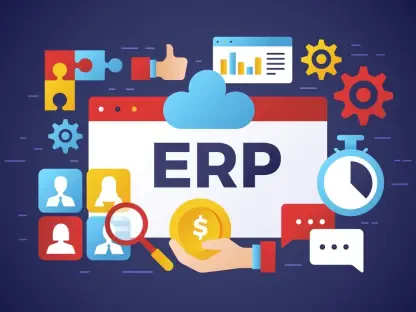Introduction
In today’s digital landscape, where businesses rely on a complex web of Software as a Service (SaaS) applications to streamline operations, a staggering number of data breaches originate from vulnerabilities in integrations between these platforms, highlighting a critical security concern. With countless organizations connecting tools like Salesforce or Zendesk to third-party apps through marketplaces, the attack surface has expanded dramatically, leaving sensitive data at risk. This growing challenge underscores the critical need to secure data flowing between SaaS applications. The purpose of this FAQ article is to provide clear guidance on protecting these integrations, addressing common concerns and offering actionable solutions. Readers can expect to explore key risks, innovative security approaches, and practical steps to safeguard their data in interconnected SaaS environments.
The scope of this content focuses on the unique vulnerabilities introduced by SaaS-to-SaaS connections and how they can be mitigated effectively. By breaking down complex issues into targeted questions, the article aims to equip both business leaders and IT professionals with the knowledge to navigate this critical aspect of cybersecurity. From understanding the nature of integration risks to implementing advanced protective measures, the insights provided here are designed to foster a safer digital ecosystem for all stakeholders.
Key Questions or Topics
What Are the Main Risks of SaaS-to-SaaS Integrations?
SaaS-to-SaaS integrations, while incredibly convenient for automating workflows and enhancing functionality, introduce significant security risks that many organizations overlook. These integrations often involve sharing sensitive data across platforms through third-party applications, creating multiple access points that can be exploited by malicious actors. Without proper oversight, a breach in one connected app can cascade across an entire ecosystem, compromising data on a massive scale.
A major challenge lies in the sheer volume of integrations and the lack of transparency around how data is accessed or protected at each connection point. Security teams often struggle to monitor who is accessing what information and whether third-party apps adhere to robust security standards. This blind spot can lead to unauthorized access or data leaks, amplifying the potential for widespread damage across interconnected systems.
Real-world incidents highlight the severity of these risks, as even a single compromised integration can affect numerous organizations. The expanded attack surface means that traditional security tools are often inadequate, leaving gaps in protection. Addressing these vulnerabilities requires a shift toward more proactive and comprehensive monitoring strategies tailored to the unique nature of SaaS ecosystems.
How Does Limited Visibility Impact Data Security in SaaS Integrations?
Limited visibility into SaaS-to-SaaS interactions poses a critical barrier to effective data security, as organizations frequently lack the tools to track data flows or detect suspicious activity. When data moves between platforms, especially through third-party integrations, there is often no clear record of access patterns or potential anomalies. This opacity makes it nearly impossible to identify threats in real time, increasing the likelihood of undetected breaches.
The absence of control over these interactions further compounds the issue, as data owners are unable to intervene quickly during a security incident. Without detailed insights into which entities are accessing data and for what purpose, organizations remain vulnerable to tampering or exfiltration. This gap in oversight can have devastating consequences, especially when sensitive customer or financial information is involved.
To mitigate these challenges, solutions must prioritize transparency and real-time monitoring capabilities. By gaining a clearer picture of data movements across integrations, security teams can establish baselines for normal activity and spot deviations that might indicate a threat. Enhancing visibility is a foundational step toward regaining control over data in distributed SaaS environments.
What Role Does a Proxy-Based System Play in Securing Integrations?
A proxy-based system offers a powerful approach to securing SaaS-to-SaaS integrations by acting as an intermediary that centralizes and monitors traffic between platforms. This setup allows for comprehensive oversight of data interactions, ensuring that every request and response is analyzed for potential risks. By routing traffic through a trusted proxy, organizations can block malicious access attempts and respond to threats without delay.
One key advantage of this system is the ability to provide detailed analytics on data access, such as identifying the source of requests or unusual usage patterns. For instance, if an integration suddenly begins extracting large volumes of data, the proxy can flag this anomaly for further investigation. This level of scrutiny helps security teams stay ahead of potential breaches before they escalate into major incidents.
Additionally, proxy systems enable rapid incident response by allowing immediate access revocation without needing to alter credentials directly on the SaaS platform. This capability reduces downtime and minimizes risk during a security event. Implementing such a system can significantly strengthen an organization’s defenses, making it a cornerstone of modern SaaS security strategies.
How Can Secure Token Management Protect Data in Integrations?
Secure token management is a critical component of protecting data in SaaS-to-SaaS integrations, particularly through innovative techniques like key splitting. This method divides authentication tokens into two separate fragments, with one part held by the third-party app and the other stored securely at the proxy’s edge. Neither fragment works independently, ensuring that data access must pass through a controlled checkpoint.
This approach drastically reduces the risk of credential theft, as a stolen fragment is useless without its counterpart. Even if attackers gain access to one piece of the token, they cannot authenticate without routing through the secure proxy, where additional safeguards are in place. Such a design transforms token management into a robust barrier against unauthorized access.
Beyond prevention, this technique supports swift incident response by allowing the deletion of one token fragment to instantly revoke access. Security teams also benefit from full audit trails of API calls, enabling them to monitor for irregularities. Adopting secure token management practices is essential for minimizing vulnerabilities in the complex web of SaaS integrations.
Why Is Collaboration Between Stakeholders Crucial for SaaS Security?
Collaboration between data owners, SaaS providers, and security vendors is vital for addressing the multifaceted challenges of SaaS-to-SaaS security. Each stakeholder brings unique perspectives and responsibilities to the table, from end-users seeking control over their data to providers aiming to enhance platform safety. Working together ensures that solutions are comprehensive and aligned with real-world needs.
For instance, data owners can define specific security requirements, while SaaS providers can integrate advanced protective features into their platforms. Security vendors contribute expertise in developing tools like proxy systems or token management protocols that benefit all parties. This shared effort helps close gaps that might otherwise be exploited by attackers targeting integration points.
Encouraging dialogue and joint initiatives, such as early access programs for new security tools, fosters trust and innovation. By pooling resources and insights, stakeholders can create a more resilient SaaS ecosystem. This collaborative mindset is a key driver in staying ahead of evolving threats and ensuring data remains protected across interconnected platforms.
Summary or Recap
This FAQ article tackles the pressing issue of securing data in SaaS-to-SaaS integrations, highlighting the primary risks posed by expanded attack surfaces and limited visibility. Key insights include the importance of proxy-based systems for centralized monitoring and rapid response, as well as the value of secure token management through methods like key splitting to prevent credential theft. The role of collaboration among stakeholders stands out as a critical factor in developing effective security measures.
The main takeaway is that protecting data in SaaS ecosystems demands a multi-layered approach, combining technological innovation with strategic partnerships. Organizations must prioritize transparency, control, and proactive threat detection to mitigate vulnerabilities. For those seeking deeper knowledge, exploring resources on zero trust architectures or SaaS security best practices can provide additional guidance on navigating this complex landscape.
Conclusion or Final Thoughts
Reflecting on the discussions held, it becomes evident that securing SaaS-to-SaaS integrations requires a forward-thinking mindset to tackle the ever-growing complexity of digital ecosystems. The journey to safeguard data demands not just reactive measures but a proactive commitment to adopting cutting-edge solutions like proxy systems and secure token protocols. These tools have proven instrumental in past efforts to bridge the visibility gap and empower organizations against breaches.
Looking ahead, the focus should shift to integrating these security practices into everyday operations, ensuring that every new integration undergoes rigorous scrutiny. Exploring partnerships with security vendors to customize solutions for specific needs emerges as a practical next step. Ultimately, the responsibility rests with each organization to assess their SaaS environment and take decisive action to fortify their defenses in an increasingly interconnected world.









